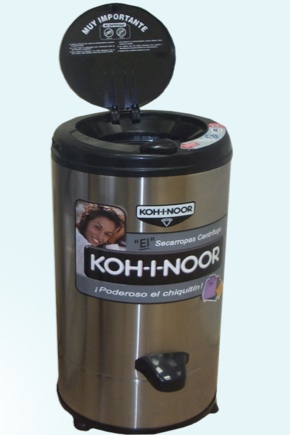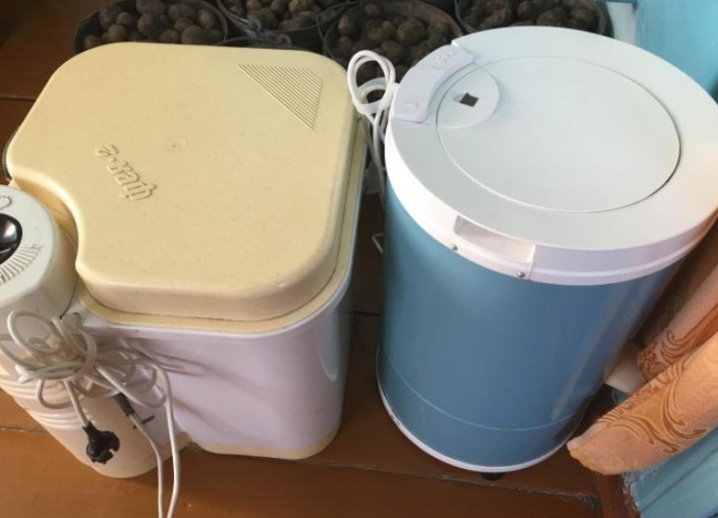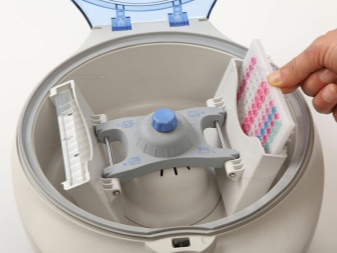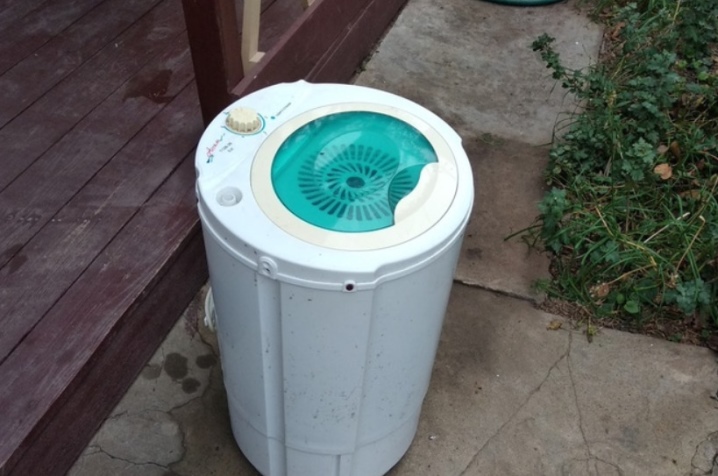Centrifuges for wringing out linen: types and selection

Centrifuges for wringing out linen are convenient and practical devices that make life much easier if there is no possibility of using an automatic washing unit. They effectively remove moisture, shortening the drying time of things, and are simply indispensable in the private sector, when drying in the air or in the laundry, but are little known to most consumers. An overview of household and industrial models such as the Fairy and other hand-held household spin dryers will help you learn more about them and make the right choice.

Features and working principle
The household type laundry centrifuge used at home is a kind of electric drying equipment. Its design is as simple as possible. It contains the following elements:
- the outer contour of the body is round or square;
- loading chamber with a sealed cover;
- vertical metal drum;
- a rotating shaft that generates centrifugal force;
- storage tank for water;
- drain hole for liquid removal;
- emergency mechanical stop pedal;
- control Panel;
- timer (optional);
- feet with anti-vibration coating that act as shock absorbers.


The main feature of the household centrifuge is the partial removal of moisture from the laundry.
It does not wring out 100%, but thin fabrics require minimal drying. - they can simply be ironed with an iron until completely dry. In addition, vibration load is one of the features of these devices, which is not completely eliminated even in the most expensive models. Some units have a built-in timer that allows you to set the spin duration, and a rinse function is provided.

The principle of operation of the device is also as simple as possible. To insert the linen, you need to open the protective panel, remove the mesh circle, and put the linen inside. The stopper then returns to its place. Its role is to keep things inside the drum as it spins. After slamming the lid, you need to connect and direct the drain hose into the sewer or a container for draining water, then all that remains is to start the rotation mechanism.

Views
All centrifuges for drying clothes are divided into household and industrial classes. Besides, depending on the type of construction, models with manual or semi-automatic control can be distinguished... They also distinguish stand-alone models that are not combined with other household appliances. They are the most mobile, compact and easy to use. Built-in centrifuges are combined with semi-automatic washing machines and allow for a faster transition between operations.



Industrial
Industrial centrifuges are called squeeze machines. They are able to remove up to 50% of residual moisture and are used as an intermediate stage between washing and drying clothes. Industrial equipment usually has a vertical loading type, equipped with an electric motor with a rotation speed of up to 1500 rpm. Some models require additional foundation construction to reduce vibration loads.

Today, for industrial purposes, centrifuges are mainly used where washing machines with a low spin speed are installed - up to 700 rpm.In some cases, their installation is associated with the need to completely transfer the removal of water from the laundry to a free-standing device. This is what they do if the goal is to increase the number of work cycles for the washing machines used.

Household
Models of centrifuges for household use are spinning equipment with a speed of 1200 to 2800 rpm, power from 100 to 350 W. These equipment options operate from a conventional 220 V network, have a cylindrical or rectangular shape.

An electric motor with a rotary or belt drive can be installed in household machines.
The linen is put into the cylinder in a certain way, starting from the bottom and along the walls. Household models have less weight, load from 2 to 6 kg, are compact in size and minimum weight, their body is most often plastic.

Manufacturers
Among the current models of centrifuges of domestic and foreign production, stand-alone models can be distinguished, characterized by compact dimensions and coping well with their tasks. Among the leaders are time-tested firms and new names for the Russian market. It is worth considering them in more detail.
Koh-I-Noor
This Argentinean-made device is considered the benchmark in the modern market. It has a separate mode for delicate materials. In terms of spin speed, the equipment under this brand is the most impressive: it develops up to 2800 rpm. Models have top loading, stainless steel tank. The spacious interior allows you to load up to 6.2 kg of laundry.


AEG
The German brand specializes in more serious equipment - climatic, heating, but it also has centrifuges for spinning linen in its arsenal. They are characterized by the presence of a housing with an anti-vibration layer, sound insulation. The model has a stainless steel foot pedal for emergency stop of drum rotation. The revs are also impressive - 2800 rpm, the internal compartment capacity is 5 kg.


"Votkinsk plant"
The famous manufacturer of centrifuges under the Feya brand. His model of a household wringer first appeared in 1982. Today the brand's assortment includes both free-standing models - for example, "Feya-Ts2000", and many combined options. They combine the functions of a semi-automatic washer and dryer.
Among the popular models are "Fairy SMPA-3502N", "Fairy SMPA-3501", "Fairy SMPA-3001".
All of them operate from a conventional household network, have a simple and reliable design. The only drawback is the small volume of the tanks: 3.5 kg for the washing compartment and 2.5 kg for the drying compartment. In addition, at low load, such structures vibrate quite noticeably.


"Great rivers"
This Russian trade mark appeared on the market in 2002. The products are produced jointly by Russia and China and are distinguished by their affordable cost.
Among the popular models of centrifuges of this brand are Nevka 7 and Nevka 6.
The models have a loading capacity of 5.8-6 kg, the tanks are made of plastic and stainless steel, the standard rotation speed is 1350 rpm.



Selection Tips
When choosing a centrifuge for wringing out linen at home, it is worth determining from the very beginning which parameters of the technique will be fundamental.

Usually, buyers mention a number of key points.
- Tank capacity. The higher it is, the more voluminous things can be squeezed out. This is important if you are going to use the centrifuge to spin warm winter jackets, bed linen, bathrobes and terry towels. The larger the capacity, the more versatile the equipment will be in application.
- Construction type. Free-standing models are more mobile and easy to store. They can be taken with you to the dacha, installed in different parts of the bathroom. Built-in options are combined with a washing machine, they are more convenient directly during washing, but such a design itself takes up quite a lot of space.
- Dimensions. The eternal problem is the storage of household appliances. The centrifuge is quite heavy and bulky. When choosing it, you need to consider whether there is a place for such a design in the bathroom or closet.
- Rotation frequency (revolutions per minute). The higher this indicator, the drier the laundry will be, more water will be wrung out per unit of time.
- The presence of sound insulation. In panel houses, this factor becomes the key to good relations with neighbors. Silent centrifuges run much quieter without sacrificing functionality.
- Type of shell. Under shock loads, the plastic base can collapse, crack. If you have a choice, it is better to give preference to the options with a steel shell from the very beginning. The tank can be aluminum or made of stainless steel alloys.
- Stability of the product. To prevent the unit from jumping around the bathroom space when spinning the linen, it is worth choosing models that provide high-quality rubber gaskets and shock absorbers. The feet must have a non-slip coating.


Considering these recommendations, it will be possible to choose the right centrifuge without unnecessary difficulties and difficulties.
In the next video, you can clearly get acquainted with the principle of operation of the centrifuge for spinning linen.













The comment was sent successfully.